Everyone loves a magical weapon. They’ve been a staple of fantasy books for as long as I’ve been reading them, starting with that moment in the Belgariad when Garion places the Orb on the pommel of Iron-Grip’s Sword and is revealed to be the true King of Riva. A hero facing a Dark Lord would no more go into battle without a magical weapon than he would do without a prophecy predicting his victory.
The problem is, the good guys don’t have a monopoly on powerful artefacts. And it’s not just the bad guys who carry weapons with a dubious history. So what happens when you find that the mystical blade is being wielded by someone on the other side to you? It’s about that time, I imagine, that the charm of the weapon begins to wear off a little.
Here are five weapons you really don’t want to see your opponent bring to a fight.
Stormbringer
Stormbringer—Michael Moorcock
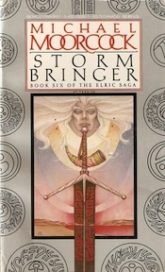 Stormbringer is the weapon of one of the most legendary figures in sword-and-sorcery fantasy, Elric of Melniboné. Strictly speaking, Stormbringer is not a sword, but rather a demon that takes the form of a sword. The first warning you’ll get that something is wrong is when the blade starts singing as it cuts down your companions. It can shear through almost any material. More disturbingly, it takes not just the lives of its victims, but also their souls. And when losing your life isn’t the worst thing that can happen in a fight, that’s probably a fight you should look to sit out.
Stormbringer is the weapon of one of the most legendary figures in sword-and-sorcery fantasy, Elric of Melniboné. Strictly speaking, Stormbringer is not a sword, but rather a demon that takes the form of a sword. The first warning you’ll get that something is wrong is when the blade starts singing as it cuts down your companions. It can shear through almost any material. More disturbingly, it takes not just the lives of its victims, but also their souls. And when losing your life isn’t the worst thing that can happen in a fight, that’s probably a fight you should look to sit out.
Of course, using Stormbringer comes at a terrible cost to the wielder–as Elric himself finds out. I’m guessing that will come as scant consolation, though, to those who have already fallen to his blade.
Dragnipur
Gardens of the Moon—Steven Erikson
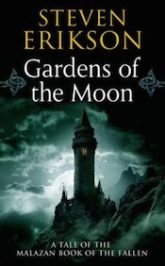 Erikson sees Moorcock’s Stormbringer and raises him with Dragnipur, the sword of Anomander Rake. Dragnipur also steals the souls of its victims, but then traps them inside a magical realm within the blade. They are chained to a cart that contains the Gate of Darkness, and forced to pull it for eternity away from the pursuing forces of Chaos. Some of the beings trapped inside the sword have been there for tens of thousands of years, among them an Elder God called Draconus. But then perhaps that is an apt punishment for Draconus, considering it was he who forged the sword in the first place.
Erikson sees Moorcock’s Stormbringer and raises him with Dragnipur, the sword of Anomander Rake. Dragnipur also steals the souls of its victims, but then traps them inside a magical realm within the blade. They are chained to a cart that contains the Gate of Darkness, and forced to pull it for eternity away from the pursuing forces of Chaos. Some of the beings trapped inside the sword have been there for tens of thousands of years, among them an Elder God called Draconus. But then perhaps that is an apt punishment for Draconus, considering it was he who forged the sword in the first place.
There’s a great scene in Gardens of the Moon when, in the middle of a festival, Anomander Rake has to clear the street in front of him of revellers. His solution? He draws Dragnipur. “The sword groaned awake, chains of smoke writhing from the blade. A terrible sound of wheels creaking filled the air and behind it arose a chorus of moaning …” Yes, that would do it.
The Subtle Knife
The Subtle Knife—Philip Pullman
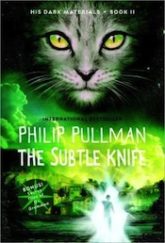 The Subtle Knife from Pulman’s His Dark Materials series is also known as Æsahættr (pronounced AS-hatter), which literally means “God-Destroyer.” That’s not a name to inspire confidence in someone facing it in a fight. The knife has a double edge. One edge is so sharp it can cut through any physical material. The other edge is sharper still, narrowing to a point so fine the eye cannot see it. In fact it’s so sharp it can cut through the fabric of the universe and create windows into other worlds. Good luck trying to parry that.
The Subtle Knife from Pulman’s His Dark Materials series is also known as Æsahættr (pronounced AS-hatter), which literally means “God-Destroyer.” That’s not a name to inspire confidence in someone facing it in a fight. The knife has a double edge. One edge is so sharp it can cut through any physical material. The other edge is sharper still, narrowing to a point so fine the eye cannot see it. In fact it’s so sharp it can cut through the fabric of the universe and create windows into other worlds. Good luck trying to parry that.
In the third book of Pulman’s trilogy, The Amber Spyglass, the bearer of the knife, Will, challenges the bear king, Iorek Byrnison, to a duel before demonstrating the power of the dagger by cutting up Iorek’s helmet. The bear king backs down promptly–and wisely.
Morgul-knife
The Fellowship of the Ring—JRR Tolkien
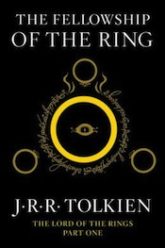 Morgul-knives are daggers used by Ringwraiths in Middle-earth. Most famously, the Witch-king of Angmar uses one to stab Frodo at Weathertop. After it cuts its victim, the knife leaves behind a splinter of the blade in the flesh. The rest of the blade disintegrates, while the splinter burrows its way into the body. If it isn’t removed quickly enough, the victim becomes a wraith.
Morgul-knives are daggers used by Ringwraiths in Middle-earth. Most famously, the Witch-king of Angmar uses one to stab Frodo at Weathertop. After it cuts its victim, the knife leaves behind a splinter of the blade in the flesh. The rest of the blade disintegrates, while the splinter burrows its way into the body. If it isn’t removed quickly enough, the victim becomes a wraith.
Only the most powerful healers are able to treat a wound inflicted by a Morgul-knife. In The Fellowship of the Ring, Elrond, Lord of Rivendell, is able to remove Frodo’s splinter, but there won’t always be an immortal elven lord standing by to tend to your injuries after a fight. And even after Frodo is healed, the wound from the Morgul-knife continues to pain him from time to time until his departure to the Undying Lands.
Snaga
Druss the Legend—David Gemmell
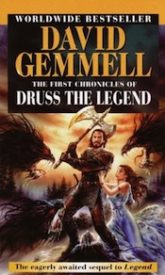 Druss is one of my favourite fantasy characters. Armed with his two-handed battleaxe, Snaga, he is all but unbeatable in a fight. In Druss the Legend, Earl Delnar explains why: “That terrible axe rarely leaves a man with a non-mortal wound. To kill Druss you have to be prepared to die. No, not just prepared. You would have to attack Druss in the sure knowledge that he will kill you. Now, most men want to live.” You don’t say.
Druss is one of my favourite fantasy characters. Armed with his two-handed battleaxe, Snaga, he is all but unbeatable in a fight. In Druss the Legend, Earl Delnar explains why: “That terrible axe rarely leaves a man with a non-mortal wound. To kill Druss you have to be prepared to die. No, not just prepared. You would have to attack Druss in the sure knowledge that he will kill you. Now, most men want to live.” You don’t say.
And Snaga is no ordinary battleaxe. A demon inhabits its blades. It can repel magic. It also corrupts its wielder, turning him into a bloodthirsty butcher, rather than the shy and retiring type you’d prefer to be facing. And even when the person carrying the axe isn’t trying to slaughter you, the demon inside might be. At one point in Druss the Legend, Snaga “slips” from Druss’s grip and tries to kill a priest it takes offence to. Only Druss’s sharp reactions save the priest from death.
Honourable mentions: The Possible Sword from China Mièville’s The Scar; Soulcutter from Fred Sabrehagen’s The Book of Swords; and Callandor, the Sword That Is Not A Sword, from Robert Jordan’s Wheel of Time series.
As I was finishing this article, it occurred to me that none of the weapons mentioned above appear in books written by women. I went back to my notes. I’d done some research online to ensure I wasn’t missing any important weapons – and I found that even my shortlist didn’t feature any books by women. So I started thinking back on my favourite fantasy series by women. The Earthsea Quartet by Ursula Le Guin? No magical weapons there that might make the list. The Farseer Trilogy by Robin Hobb? Another no. For fans of Dragonlance, Margaret Weis (and Tracy Hickman) introduced us to a real menagerie of magical weapons. But the likes of a dragonlance wouldn’t trouble you overly in a fight, unless you happened to be a dragon. And I’m assuming you’re not.
So this is where you enlighten me. Which magical weapons featuring in books written by women deserve to be in a top five?
Originally published in May 2015 as part of our Five Books series.
 Marc Turner was born in Toronto, Canada, but grew up in England. He graduated from Lincoln College, Oxford University, in 1996 with a BA (Hons) in Law, and subsequently worked at a top-ten law firm in London. After more than ten years in the legal profession he gave in to his lifelong writing addiction and now works full time as a writer. When the Heavens Fall is the first novel in his Chronicles of the Exile series.
Marc Turner was born in Toronto, Canada, but grew up in England. He graduated from Lincoln College, Oxford University, in 1996 with a BA (Hons) in Law, and subsequently worked at a top-ten law firm in London. After more than ten years in the legal profession he gave in to his lifelong writing addiction and now works full time as a writer. When the Heavens Fall is the first novel in his Chronicles of the Exile series.










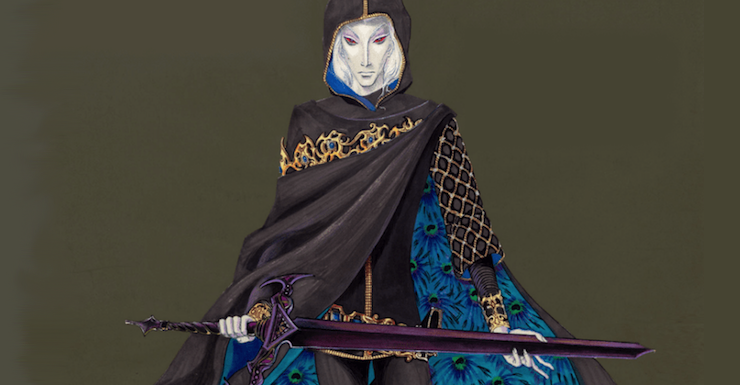
Morgaine’s sword Changeling! From C.J. Cherryh’s Gate of Ivrel et al. The blade is of crystal, but you probably won’t get much chance to admire it as you’re sucked into the howling vortex of the Gate at its tip and (if you’re very, very, very luck) spat out … elsewhere.
Alas…I cannot think of one in books authored by women. I will keep trying.
That said, I would add Blackwand, Pathfinder, Iceflame, and Godslayer from the Vlad Taltos novels by Steven Brust.
Changeling, Morgaine’s sword in C. J. Cherryh’s four Morgaine novels. It is not actually a sword but a dimensional gate.
There’s Need, the sword in Mercedes Lackey’s Valdemar series – a blade that (at first) gives magic protection to a warrior and expert fighting skills to a mage, and heals anyone – women only as wielders though, she’s just a blade for a man. Later it’s revealed Need was actually a mage-blacksmith for an ancient school of sorceress-nuns, and sealed her soul into the enchanted blade when they were wiped out by invaders.
CJ Cherryh’s Morgaine wields a sword called Changeling – these are science fantasy stories, so there’s a sort of magi-tech to it.
Can’t think of any others at the moment.
Gonturan, from Robin McKinley’s Damar books.
Diane Duane has two magical swords in The Tale of The Five: Herewiss’s self-forged sword which is his focus and control of the Flame, and Segnbora’s sword, which is made from a piece of the Door Into Starlight, and is one of those “will cut through anything” swords. Conveniently, it is a sword with personality and attitude, and won’t cut its wielder’s hand.
Anne McCaffrey’s heroine Killashandra Ree weilds a crystal cutter with the aid of her singing voice. I’m guessing that getting in the path of that would not turn out well….
Vera. In the hands of Jayne Cobb, almost unbeatable.
Alanna had a couple of nifty swords in Pierce’s Song of the Lioness books. Nothing as powerful as the other stuff mentioned here, but still pretty good, pretty serviceable.
Brandon Sanderson created a good one in ‘Nightblood’ in the novel Warbreaker (also makes an appearance in a later Sanderson novel). It is a sentient sword that really enjoys destroying evil.
Darkover (by Marion Zimmer Bradley) has a number of weapons, though perhaps Clingfire and Bonewater Dust might not count, but the Sharra Matrix certainly does. It’s in the hilt of a sword, so it’s not technically a sword, but a dimensional gate (hey, am I repeating something…)
The Darksword counts for 50% with Margaret Weis.
Kate Daniels by Ilona Andrews wields Slayer, a sword that hungers for undead (it actually liquefies undead flesh) and needs to be fed in order for the blade not to turn brittle. Later she gets another one (names escapes me) and it is revealed *SPOILERS* that the swords are actually made from the bones of her grandmother, a very powerful sorceress queen.
Boreal and Samiel, the jivatmas in Jennifer Roberson’s Tiger and Del novels.
So glad you included Callandor from WoT – not only do you not want your enemy to bring that, but knowing how it can’t really be controlled (seen in Rand’s battle against the Seanchean when he rained lightning down on both sides), you kinda don’t want your allies to bring it either!
EXCUSE ME WHERE’S NIGHTBLOOD?
Though it’s very similar to Stormbringer I would add the Sword of Suchara, Daubendiek, From Glen Cook’s The Swordbearer.
Brust’s entire collection of Morganti weapons that don’t just eat your soul; but rend it to tatters first.
@12 — Yes! I should’ve remembered Del & Tiger …
Jame from PC Hodgell’s Kencyrath books at times carries the Ivory Knife, the Book Bound in Pale Leather and a really creepy (but oh, so neat) cloak made from live snakes.
Jason @9, that really enjoys destroying evil … LOL. Yeah, you could say that.
VladZ @11, I’m so glad to see somebody mentioning Slayer! I hadn’t read Kate Daniels’s books yet when this article was first published, but Slayer and Sarrat definitely deserve to be in this list!
And agree with Kalvin @13.
I came to the comments to mention Gonturan from McKinley’s Damar; glad to see the Woman’s Sword already got a mention here!
For swords by male-authored works, yes, Nightblood from Cosmere, as mentioned above. (Also a great ‘character,’ not just a blade!) There’s also the titular Sword of Shannara from Brooks’ series. Aaaaand Memory, Sorrow, and Thorn… the three swords from the, yes, Memory, Sorrow, and Thorn series by Tad Williams….
Shardblades from the Stormlight Archive. And Nightblood from Warbreaker, both by Brandon Sanderson. *shudder* would not want to face someone holding one of those
I’d add Raging Heart from Mahou Shoujo Lyrical Nanoha. It’s a gem that turns into a magic staff. It turned an untrained little girl into a magical engine of mass destruction capable of generating (magically non-fatal) multi-megaton range explosions.
Soul Blades from Lindsey Buroker’s Dragon Blood series. When a mage was about to die they could chose to put their soul into a sword and make it sentient. The holder of the sword has access to both the mage’s power and knowledge.
Jaxi is not only a sword and mage but quite the snarky character.
22, technically that would apply to any of the Magical Devices. Though the Cradle might go beyond the norm.
And The Book. Don’t forget The Book.
25, yeah I was going to mention that, but then I was like, doesn’t the Cradle go one further?
Of course, in that series, somehow they’ve gone into Loli-MMA and I just don’t know what to say about that.
Marc,
Years after David Eddings wrote the Belgariad series (and its sequel, the Malloreon series), he credited hiss wife Leigh as a co-author. Thus, one could argue that the Belgariad/Malloereon were written by a woman. As such, the Sword of Riva (as long as the Orb is in the pommel) would answer your last question.
Two other swords are the Blade of Heaven and the Blade of Power in the Brent Weeks’ The Night Angel Trilogy.
Thanks for reading my musings.
AndrewHB
Solid list – I read all the comments and couraflamme is not mentioned, its the sword used by Gord the Rogue in the Gary Gygax series of the same name. Its two, two, two swords in one! One half crystal and one ebon metal and it is the most powerful magical item in all the planes of existence except the theopart. It can split in two and do all kinds of deadly murderous demon killing things.
Vengeance (or Grief) from the Malazan Book of the Fallen should be an honorable mention. You cannot be defeated while wielding it if you have a strong enough will, and it was the sword that defeated Dragnipur.
While I can’t offhand recollect any comparable weapons written by a woman, I can think of a couple in the Taltos books which have feminine connections. Sethra Lavode is perhaps the scariest character in those books, and her sword definitely contributes to that. And then there’s Lady Teldra… Wouldn’t want to meet either of those in combat.
~lakesidey
So I see I was beaten to naming Gonturan – The Blue Sword. Brings down mountains you know.
There is also the silver daggers of Katherine Kerr’s Deverry series, they will always return to their owner.
31, was it owner or maker? I seem to recall the smith’s spells leading them to him, except maybe for Rhodry.
I would have picked Callandor for my top five. I mean it’s the trick with the sword that won the day in AMoL.
Agreed on Nightblood. Doesn’t even need to be fully drawn to be deadly…
The Earthsea Quartet by Ursula Le Guin? No magical weapons there that might make the list.
In “The Farthest Shore” Cob, the villain, carries the sword of Erreth-Akbe and kills a dragon with it. It doesn’t help him much, because it turns out that if a dragon crash-lands on top of you, you die, even if the dragon is dying at the time because you’ve just stabbed it.
Still, magic sword.
I don’t know if this exactly qualifies since it’s technically in the SF realm, but since there’s an Iain Banks series going on, and the result is indistinguishable from magic, I would humbly suggest the Lazy Gun as described in Mr. Banks’ novel Against a Dark Background.
The Lazy Gun will always kill the target. It’s capable of doing so in a number of different and imaginative ways, though the larger the target, the less imaginative the solutions become. A single person might have a piano fall on them. Larger targets tend to just be obliterated by whatever handy method is available.
36, so a lot of giant whales falling from the sky?
1) If you mention Stormbringer you must include Mourneblade
2) Gurthang—killed a dragon, killed a best friend,then told Turin it would take his life to ease the pain of killing the best friend. No one names evil talking swords like Tolkien
N. K. Jemisin’s Obelisk Gate (Broken Earth trilogy). An individual one of the giant floating crystal amplifiers would be a devastating weapon if any of the surviving inhabitants of the world knew what they were, or could trust the people who can access them. Linked together into the network they were designed to be used as, the Obelisk Gate gives unimaginable control over not only the very substance of the planet, but also the hidden magical forces woven through every atom; it’s merely an unfortunate quirk that its default setting, for those not strong-willed enough resist, would be the eradication of all human life.
If you’re looking for something a bit more human-scale, Elizabeth Bear turns a steampunk sewing machine into a suit of power armor in Karen Memory. It doesn’t make her invincible by any means, but it keeps her from getting shot a number of times, and helps her fight an iron-tentacled submersible on more even footing.
In Midori Snyder’s Queen’s Quarter/Oran’s Trilogy series, the fire swords of the Fire Queens are magical blades used to help harness their dangerous element–and Queen Zorah uses hers as the focus to steal time, which wrecks the balance of Oran and its magical elements, barely holding it together on the blade’s edge, all to maintain her own youth and beauty and hold back death, which terrifies her beyond reason. Which is why a new Queen’s Knot must be formed with new elemental queens, before the world is torn apart and thrown into Chaos.
Overall, though, I’m reminded of a quote from…somewhere, about it being a very male thing to name weapons; it’s entirely escaping me where I heard it though, but it was fantasy genre, I am sure.
Reaperman Terry Pratchett
Death’s scythe so sharp it cuts words
Based on the comments, I observe the following inequalities re: magical weapons with names in written SFF:
* Male carriers > females
* Hero carriers > villains
* Swords > any other type of melee or ranged weapon
Things trend differently in TV and anime. Xena carries her signature chakram, although the razor-edged flying disc doesn’t have a name. Magical girls often have talking wands. In Silent Mobius (manga and 1991 anime), Katsumi Liqueur carries Grospolina, the so-called King of Swords, who in resting form resembles a cow’s skull. In Saturn Moon, Sailor Saturn has the Silence Glaive, which can destroy a planet (and kills the user). There’s the occasional heritage mecha, as with the titular Escaflowne (1996), which forms a blood-pact with its operator.
The various Transformers TV series have introduced a range of sentient-or-named weapons. Armada (2002) has the Star Saber, Skyboom Shield and Requiem Blaster, each formed from three Minicons (a race of undersized Transformers who can attach to and boost the power of a larger partner, not always willingly, which is why they fled Cybertron). Prime (2010) has the Forge of Solus Prime (an oversized hammer that can craft anything from base matter, in addition to delivering a mighty wallop), the Apex Armor (a breastplate that can transform into a full-body armor suit of any size) the Star Saber (same name, different artifact), and the Dark Star Saber (made by Megatron using the Forge of Solus Prime from Dark Energon, the blood of antigod Unicron).
They’re not exactly from novels, but a few D&D swords come to mind.
The Holy Avenger is quite a potent weapon in the hands of a paladin, protecting its wielder from hostile magic and enchanted to be brutally effective in combat (even more-so against undead and fiends).
Hazirawn from the Rise of Tiamat module is an evil, semi-intelligent zweihander that saps the life force of whoever it strikes. It can also allow the wielder to cast a handful of spells designed to find, interrogate, and kill mages.
The Blackrazor is an infamous artifact sword that consumes the soul of what you kill with it and provides healing to the wielder, while working to influence the user toward ever more indiscriminate slaughter.
It’s not magic, but the Darksaber in Star Wars first appears in an episode written by a woman.
Here is an obscure one; the black dagger, from Lawrence Watt-Evans’s book, The Spell Of The Black Dagger. A weapon created by a thief as a botched attempt to create an athame, because she wanted to be a wizard. The dagger takes the life force of the person killed, and imparts it to the wielder, allowing them to accumulate multiple lives. If the wielder takes a mortal wound, a “life” is expended from the dagger, and they are magically healed. A very nasty weapon indeed.
The Demon weapons and their Meisters from the Soul Eater graphic novel are pretty formidable to. Demon weapons are living, breathing creatures in human form who can transform into physical weapon form to fight/ be wielded by their Meisters.
The Coldfire Trilogy written by C.S. Friedman features a sword used by Gerald Tarant, The Hunter, which is infused with Coldfire. As I remember, the sword can only be used by Tarant and had specific properties that made it a very dangerous weapon, but, I don’t remember the sword having its own name, so it might not fit your criteria for that reason.
The problem with Nightblood is that he’s just as dangerous to the wielder as he is to his enemies. He’s a sword that you don’t want to see period. Living Shardblades totally deserve a spot on the list, however.
As for weapons from female written series, does the Elder Wand count? Not a blade, but still, it was made with dueling in mind.
Caladan Brood’s hammer in Malazan is capable of some pretty intense, apocalyptic damage if swung at full strength.
I upvote Shardblades and Nightblood… Especially Shardblades that aren’t dead… and the weapon Moash used to kill the God..
Morgul-knife? Gurthang? Please. In that legendarium, Ents and the occasional wizard can wield a migratory, weaponzied forest against you! That’s far more intimidating than any melee or ranged weapon, magic-infused or not.
I imagine the prospect of being hit by the Point-of-View Gun must be truly terrifying for some. Of course, its scariness is somewhat mitigated by being useless against roughly half the population…
@48/AyeJaySedai: The Elder Wand seems a subversion of the trope. Its history indicates that any wizard powerful enough to wield it effectively could probably beat you just as easily without it; while for anyone of lesser skill/power, the possible temporary advantage it may provide in any particular duel seems outweighed by the pressure of an unending stream of new challengers. Of course, JKR’s Dumbledore’s commentary on the demographics of its ownership provide some good food for thought regarding the apparent dearth of uberweapons from female authors…
Totally second all shardblades, living OR dead (nominated them myself in the original post, so did not want to repeat myself, but could not help myself from giving them another vote now).
Being magical is often all relative – so in Joy Chant’s “Red Moon and Black Mountain ” it is a simple pocket knife from our world wielded by Oliver (‘Young Tiger’) that kills the evil enchanter Fendarl, who cannot be hurt by “any creature of this world”. Even the sword of Emneron, is a creature of that world, but a knife from our world is beyond the world of Red Moon and Black Mountain and so kills Fendarl, he “who had never thought to die”.
Thomas Covenant’s White Gold Ring? It’s not a blade, but it can destroy time.
@54,
Other drastic effects of the White Gold Ring: self-pity, tendency to make stupid choices (see Gurthang), horrific overuse of adjectives
Yeah, I have to upvote shardblades, and Tarrant’s sword.
But also, what about the Sword of Tears from Richard Knaak’s The Legend of Huma (Dragonlance)? That is a terrifying weapon!
Does video game swords count? Umbra in Elder Scrolls is weilded by a woman of the same name.
Jacqueline Carey’s duology “The Sundering” has a knife called Godslayer, which, surprise, surprise, can slay gods.
I’m super happy to see Need, Gonturan, Changeling, and Katherine Kerr’s silver daggers from Deverry have already been listed.
Lady Teldra from the Jhereg novels.
There’s also the magical sword, Need. She teaches you how to fight and use magic, shoring up your skills in the one you aren’t proficient in. She belongs in Kerowin’s ride, and some of the books before and after that one. All written by Mercedes Lackey.
60, Need does appear in some of the anthology stories. I’m not sure if Need is in any of the books co-authored with her husband though.
The Frying Pan of Doom (which was supposed to be a powerful sword) from the short story “Utensile Strength” from Book of Enchantments by Patricia C. Wrede is pretty great.
Samiel, Sandtiger’s magical sword from the Tiger and Del series by Jennifer Roberson
Re: 32 – Technically owner, however the maker just considered that to be him when he was applying the magic, the bearers only paying a rental fee.
65, yes, I can imagine that being his attitude.
I’m surprised to see that the Elder Wand got mentioned before the Sword of Gryffindor…
Fidelacchius, Amoracchius, and Esperacchius, though if you find yourself in combat against them you probably earned it (and have nothing to fear if you didn’t).
Practically anything from Warhammer 40,000, though the various Daemonweapons seem like the category most likely to be horrifyingly unpleasant to go up against.
No mention yet of Wirikidor, the title character — er, sword — of Lawrence Watt-Evans’ The Misenchanted Sword. It’s so bound to its owner that he can’t throw it away. He’s unbeatable with it; his opponent will die, no other possible outcome, as long as there’s only one opponent. Once drawn, it can’t be sheathed until its wielder has killed a man. But it’s only good for 100 successful fights, after which it will kill its own wielder. The next owner gets it for 99 fights, then 98, and so on. And oh yeah, the owner can ONLY die by being killed by his own sword. And the sword is indestructible.
69, but wait, there’s more! The owner can’t die. But he does get older. Well, at least until he meets a wizard who decides that immortality with him isn’t so bad. So there’s still the question of whether he can die of old age.
The Heart of War, from the Legend of Eli Monpress by Rachael Aaron (= Rachael Bach). It’s “Not even sharp!” but it cuts through anything. A couple of other pretty scary swords in that series – it doesn’t help that they’re all sentient.
The elemental blades from Elizabeth Haydon’s Symphony of Ages likely counts. The water blade essentially allowing you to redirect a river temporarily sounds terrifying.
Sceptre of the ancients?
My enemy you are done ….
Gotreks axe in the gotrek and felix books and excaliber from numerous sources
Or Terry good kinds the sword of truth
Old article I know but I didn’t see Saberhagen’s Swords listed.
Here they are:
1) Townsaver: The Sword of Fury
2) Shieldbreaker: The Sword of Force
3) Stonecutter: The Sword of Siege
4) Woundhealer: The Sword of Mercy/The Sword of Love
5) Doomgiver: The Sword of Justice
6) Coinspinner: The Sword of Chance/The Sword of Fortune
7) Dragonslicer: The Sword of Heroes
8) Farslayer: The Sword of Vengeance
9) Mindsword: The Sword of Glory/Skulltwister/The Sword of Madness
10) Sightblinder: The Sword of Stealth
11) Wayfinder: The Sword of Wisdom
12) Soulcutter: The Sword of Despair/The Tyrant’s Blade
All had their flaws & weaknesses, to be sure. But they all gave your enemy pause if they knew you carried on of these twelve blades.
Kato